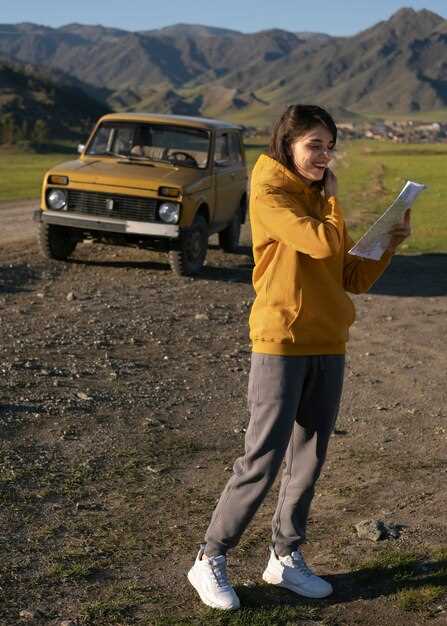Always check your vehicle’s condition before hitting the trails. Inspect tire pressure, fluid levels, and brakes to ensure everything is functioning optimally. A quick glance can prevent troubles during your adventure.
Next, pack a reliable toolkit and emergency supplies such as a first-aid kit, flashlight, and extra food and water. Being prepared for the unexpected keeps you safe and enhances your off-roading experience.
Communicate your plans with someone who will stay behind. Let them know your intended route and estimated return time. This simple act can make a significant difference in case something goes wrong.
Always stay informed about local regulations and trail conditions. Check weather forecasts and road closures before you set out. Being aware of potential hazards or changes in the environment allows you to make better decisions while on the trail.
Practice good driving techniques. Approach steep terrains slowly, maintain a safe distance from other vehicles, and don’t speed. Mastering control over your vehicle reduces risks and enhances safety for everyone present.
Understanding Your Vehicle’s Off-Road Capabilities
Check your vehicle’s manufacturer specifications for off-road features. Look for ground clearance, approach and departure angles, and axle articulation. A vehicle with higher ground clearance allows you to tackle obstacles like rocks and logs without getting stuck.
Understand your vehicle’s drivetrain. Four-wheel drive (4WD) is a must for off-roading, particularly with low-range gearing for steep and rugged terrain. Know if your vehicle utilizes full-time or part-time 4WD, as this impacts how power is distributed to the wheels.
Test your vehicle’s traction control systems. Features like locking differentials improve grip on uneven surfaces, while traction control prevents spinning wheels on loose terrains. Experiment with these systems in a controlled environment to understand their operation.
Get familiar with your vehicle’s suspension. A robust suspension absorbs impact, ensuring better tire contact with the ground and improved handling. Vehicles with long-travel suspension systems are more capable in rough environments.
Assess your approach and departure angles. Vehicles with steeper angles can navigate inclines and declines without damaging the front or rear. Measure these angles, as they’re crucial when facing steep terrains.
Examine the tires on your vehicle. Off-road tires with deep treads provide better grip in mud, sand, and loose gravel. Ensure they are properly inflated and in good condition before heading out.
Finally, educate yourself about your vehicle’s weight distribution. A well-balanced vehicle performs better in challenging conditions. Carry additional weight low in the vehicle to enhance stability.
Pre-Trip Vehicle Inspection Checklist
Check tire pressure and tread depth. Properly inflated tires with good tread provide better traction on rough terrain. Always carry a pressure gauge and ensure all tires, including the spare, meet manufacturer recommendations.
Inspect fluid levels. Verify that the oil, coolant, brake fluid, and transmission fluid are at optimal levels. Top off any fluids before you set off to prevent overheating or system failures during your trip.
Examine brakes and lights. Test the brake system to confirm it responds effectively. Ensure all headlights, taillights, and turn signals function properly, enhancing visibility and safety on rugged paths.
Check battery health. Clean any corrosion from battery terminals and ensure connections are tight. A well-maintained battery prevents unexpected breakdowns, especially in remote locations.
Test the four-wheel drive system. Engage and disengage the four-wheel drive to ensure it’s operating smoothly. Pay attention to any unusual sounds or resistance.
Inspect the undercarriage. Look for loose parts, leaks, or damage that could affect the vehicle’s performance. Pay special attention to differential and axle components.
Verify emergency equipment. Keep a well-stocked first-aid kit, a spare tire, and essential tools. Include items like a jack, tire iron, and a flashlight as part of your safety gear.
Examine interior accessories. Check the operation of seatbelts and ensure that any loose items are secured inside the vehicle. A tidy cabin reduces distractions while off-roading.
Test navigation and communication devices. Ensure maps and GPS devices are functioning. A reliable way to communicate with others in case of an emergency is also crucial.
Conduct a general cleanliness check. Remove any unnecessary weight by clearing out items that won’t be used. A lighter vehicle performs better and uses less fuel.
Complete your checklist before each trip. Regular inspections help avoid mishaps and ensure a safer off-roading adventure.
Essential Safety Gear for Off-Road Adventures
A helmet is a must-have for any off-road rider. Choose one that fits snugly, offers full-face protection, and has proper ventilation to keep you cool during warm days.
Protective goggles shield your eyes from dust, debris, and UV rays. Look for goggles with anti-fog lenses and a comfortable fit to ensure they stay in place while navigating bumpy terrains.
A durable, moisture-wicking helmet liner enhances comfort and reduces sweat buildup, which helps maintain focus on the ride. Consider liners that are machine-washable for easy maintenance.
Wear padded gloves to improve grip and protect your hands from blisters and impact. Select gloves made from breathable materials that offer dexterity while still providing necessary shielding.
Sturdy boots with ankle support are essential. Choose models with oil-resistant soles to improve traction and protect your feet from sharp objects and rocks on off-road trails.
Body armor, including knee and elbow pads, reduces the risk of injury during falls. Look for lightweight options that allow for flexibility and breathability, ensuring comfort while you ride.
Consider a riding jacket with reinforced sections. Opt for one with ventilation, adjustable cuffs, and multiple pockets for carrying essentials while keeping you protected from the elements.
Carry a first-aid kit tailored for off-road activities. Include items like antiseptics, bandages, and pain relievers to address minor injuries quickly and effectively.
A reliable communication device enhances safety in case of emergencies. Consider two-way radios or a satellite phone for areas with limited cell coverage, ensuring you can call for help when needed.
Lastly, invest in a sturdy and well-organized tool kit, complete with basic tools that can assist with quick repairs or adjustments to your vehicle during the adventure.
Navigating Different Terrain Types Safely
Adjust tire pressure before tackling sandy terrains; lowering it increases surface area and improves traction. Engage a lower gear to maintain momentum while preventing the vehicle from getting stuck.
On rocky paths, approach obstacles slowly and prefer to drive over large rocks rather than trying to avoid them. Scan ahead for potential hazards and choose your line carefully to avoid damaging suspension components.
In muddy conditions, maintain steady speed to prevent sinking. Utilize momentum carefully but avoid sudden acceleration, which can lead to loss of control. Look for dryer patches of earth when possible to help maintain grip.
When driving through water crossings, assess water depth first. Avoid depths exceeding the vehicle’s recommended waterproof level. Use a low gear to keep the engine revs up and prevent stalling in water.
For steep inclines, focus on keeping a steady speed without sudden throttle changes. Shift weight slightly forward to enhance traction on the rear wheels. While descending, use low gear to control your speed and maximize engine braking.
On snowy trails, keep tire pressure slightly higher than normal for better traction. Stay in tracks made by other vehicles as they provide a firmer surface. Avoid sudden steering or braking to maintain stability.
In all situations, communication with your off-roading partners is key. Use hand signals or walkie-talkies to relay instructions or share updates, ensuring everyone stays coordinated and safe during the adventure.
How to Handle Mechanical Breakdowns in Remote Areas
Carry a basic toolkit with you on off-road trips. Include wrenches, screwdrivers, pliers, duct tape, and spare fuses. These tools can help you address minor issues on-site without waiting for assistance.
Before you head out, familiarize yourself with your vehicle’s manual. Understanding your vehicle’s systems can help you diagnose problems quickly. Check fluid levels, tire pressure, and battery conditions beforehand to reduce the likelihood of breakdowns.
If you experience a breakdown, first secure the area. Turn on hazard lights and place reflective triangles or cones around your vehicle to alert other drivers. This increases your visibility and safety.
Assess the situation calmly. Identify the problem, whether it’s a flat tire, engine overheating, or something else. If you can self-repair, follow the steps in your manual. For a flat tire, know how to change it efficiently.
If repairs aren’t feasible, communicate your location using emergency services. Use a mobile phone or a satellite communicator for assistance. Ensure someone knows your expected route, so they can provide help if you don’t return as planned.
When waiting for help, stay with your vehicle if possible. It provides shelter and is easier for rescuers to locate. Conserve resources like food and water until assistance arrives.
Enhance your preparedness by joining off-road clubs or online communities for knowledge-sharing. Other enthusiasts can provide invaluable tips and support in case of an breakdown.
Emergency Communication Techniques for Off-Roading
Carry a satellite phone for reliable communication when cellular networks fail. These devices allow you to send messages and make calls from remote areas.
Invest in a two-way radio system. They facilitate communication between vehicles, especially in groups. Ensure all members know the channels and can operate the radios.
Use personal locator beacons (PLBs). These devices can send distress signals to rescue services, even when you are outside terrestrial coverage.
Establish hand signals or visual markers with your group. When noise is an issue, these methods help maintain contact without verbal communication.
Keep a map and compass on hand. These tools aid in navigation and can assist rescuers in locating you if communication methods fail.
Share your planned route and estimated return time with someone outside your group. This ensures someone will know to alert authorities if you go missing.
During your trip, check in regularly with your designated contact. Even brief updates can provide peace of mind to others and facilitate timely help if needed.
Consider using a GPS tracking device. This allows friends or family to follow your location in real-time, enhancing safety for solo off-roading trips.
Participate in off-road recovery courses. These teach communication techniques alongside recovery skills, ensuring that you are prepared for various scenarios.
Practice emergency scenarios with your group. Role-playing can help everyone understand how to communicate effectively under stress.







